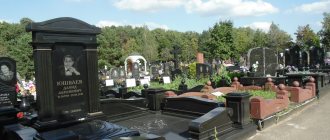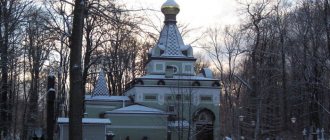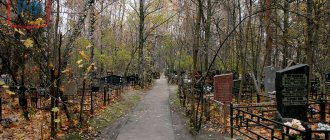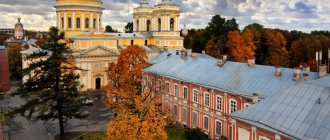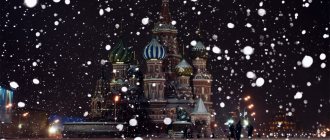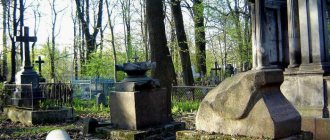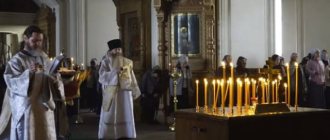There are a large number of cemeteries where every deceased person finds their peace. In small towns and villages, finding a place is not difficult, but in cities, especially very large ones, this can become a real problem. Moreover, in such large cities there are certain burial places where ordinary people are not allowed to be buried. These cemeteries are reserved only for those who have made significant public contributions to government affairs. These include the graves of celebrities at the Vagankovskoye cemetery.
Cemetery Vagankovsky. Celebrity graves
The Vagankovskoe cemetery, a necropolis with a two-century history, hundreds of thousands of graves and half a million buried, was founded in the 18th century, after the plague in Moscow. Previously, in the 15th-16th centuries, the settlement of Vagankovo was located here - the royal amusement court, where jesters, buffoons and the sovereign's amusing people played pranks to their hearts' content. This name was assigned to the cemetery, which, following the victims of the epidemic, received the graves of ordinary people - townspeople, artisans, minor officials. In the 19th century, famous compatriots from the world of culture began to be buried here - first, artists of the Imperial Theater, artists, writers, people of art, and after almost two centuries this tradition was finally consolidated. Now the graves of celebrities at the Vagankovskoye cemetery are numerous, overgrown with legends and have become a place of “pilgrimage” for thousands of visitors every year.
origin of name
The cemetery got its name from the name of the village. There are several versions of the origin of the name of the settlement. According to the most common hypothesis, it is associated with the verb “vaganit” - this word is in Dahl’s dictionary, it means “to indulge, make laugh, joke.” Some researchers prefer to associate the name of the village with “vaganna” - that was the name of the tax for weighing goods. Another version is the name of rude and “uncouth” men - they were called the word “vagan”.
Great Russian painters - merchant, serf and Cossack
Under the restrained dark granite tombstones with the indispensable Orthodox crosses at the Vagankovskoye cemetery lie the textbook artists of Russia.
Alexey Savrasov, a landscape painter of the merchant class, teacher of Isaac Levitan, was among the founders of the Society of Itinerants. His most recognizable painting, “The Rooks Have Arrived,” depicts the Church of the Ascension in the village of Susanino, Kostroma province.
The outstanding portrait painter Vasily Tropinin is the son of a serf peasant. His artistic gift was noticed by notable patrons of the arts. Tropinin received an academic education, painted romantic, then increasingly realistic type portraits, full of soft charm.
Vasily Surikov on his maternal and paternal lines came from glorious Cossack families. This artist is best known for his large-scale historical paintings “The Morning of the Streltsy Execution”, “Menshikov in Berezovo”, “Boyaryna Morozova”, “Suvorov’s Crossing of the Alps”.
The tombstones of the great Russian painters - merchant, serf and Cossack - are installed above iconic burials in a long row, which is formed by the graves of celebrities at the Vagankovskoye cemetery.
Moscow cemeteries
Is it appropriate to visit the territory on excursions?
Sightseeing tours are held weekly at the Vagankovskoye cemetery. This is not surprising: the necropolis has a long history; over the years it has turned into an architectural monument. Among those buried on the territory of the necropolis are outstanding personalities; amazing sculptures are installed on their graves. And it is completely normal that people from different parts of Russia and other countries come here to honor the memory of the deceased, lay flowers at their graves, and read poetry.
Mass graves as milestones in history
The Vagankovskoe cemetery, founded during the epidemic, was initially a place of mass burials. Later the following were buried here:
- those who fell in the turning point and bloody Battle of Borodino in 1812;
- those who died in a mass stampede on Khodynka Field during celebrations of the coronation of Nicholas II in 1896;
- victims of mass repressions of the 1930s;
- defenders of Moscow who stopped Hitler's blitzkrieg with a counteroffensive in 1941-1942.
These mass graves at the Vagankovskoye cemetery remind us of the tragic death of many of our compatriots.
Diagram showing graves
The Vagankovskoe cemetery is very extensive, without any plan or diagram, it is impossible to get your bearings. The diagram presented in the photo shows the location of 60 burial sites, each of which has its own number.
Two mass graves and an Orthodox Church are indicated. The paths between the sections also have their own names. Also, opposite the Vagankovsky cemetery, there is the Armenian cemetery, which is its branch.
Yesenin's grave.
Under the monument of dark and light gray granite lies a great poet with a unique lyrical gift. In the past are the marvelous blue eyes, the “gold and copper” of the hair, the enchanting scandals with which Yesenin tormented Isadora Duncan in Europe and America, the gloomy suicide in the Petrograd Angleterre and the last poem written in his own blood. Immortal, heartfelt, strikingly imaginative lyrics are published, read, and sung again.
Next to the pedestal with gilded letters and a block of light gray marble with a half-length sculptural portrait of Sergei Yesenin there is a low tombstone of his mother, and Galina Benislavskaya, who during her life was called the poet’s “good angel,” is buried behind. The very next winter after his death, in December 1926, she came to Yesenin’s grave and committed suicide with a shot in the head - after all, in this piece of land, as she wrote before her death, there was everything dear to her. Here, next to the ashes of the great poet, who embodied the lyrical spirit of Russia in his poems, several more suicides of his fans occurred over the years.
Necropolis of plots
Photo from places.moscow
Of course, the list of celebrities buried here is not limited to Vysotsky and Yesenin. Decembrist Mikhail Bestuzhev, writer Veniamin Kaverin, artists Vasily Surikov, Vasily Pukirev, Aristarkh Lentulov, conductor Evgeny Svetlanov, director Vsevolod Meyerhold, actors Alexander Abulov, Oleg Dal, Mikhail Kononov, Georgy Yumatov, Spartak Mishulin, Leonid Filatov, coach Anatoly Tarasov, football player Nikolai Starostin, figure skater Lyudmila Pakhomova.
For a long time, a dilapidated wooden cross crowned the grave of the great painter Alexei Savrasov - at the end of his life, he became an alcoholic, became depressed and died all alone in a hospital for the poor. Then a granite obelisk worthy of Alexei Kondratyevich appeared there.
The creator of the famous Museum of Fine Arts, Ivan Vladimirovich Tsvetaev, is also buried here. “According to the will of the deceased, there were no speeches at the grave,” the newspapers reported. Being an incredibly modest person during his life, he remained so even after death.
Director Yuri Zavadsky, in accordance with all his titles, should have rested at Novodevichy. But in his will he clearly indicated: only Vagankovo. Government officials at the highest levels insisted on strict adherence to the cemetery hierarchy. But in the end, the last will of the deceased prevailed.
The Vagankovskoe cemetery is rich in stories.
Stars of the stage
The galaxy of famous theater people buried at the Vagankovsky cemetery is opened by Pavel Mochalov, an outstanding romantic actor of the 19th century. His uneven performance made a deep impression: the audience came to performances because of the famous “Mochalov minutes,” when, against the background of an ordinary, unremarkable performance, several incredibly effective lines suddenly appeared, followed by a flurry of enthusiastic applause.
Director-reformer, symbolist, futurist, master of the grotesque Vsevolod Meyerhold was repressed in 1939, shot in 1940, cremated and buried among the unclaimed ashes at the Donskoy Monastery. However, the tombstone over the empty grave is located at the Vagankovskoye cemetery - the monument was erected shortly after Meyerhold’s posthumous rehabilitation, when the location of his remains was not yet known.
The burial of the incredibly popular People's Artist of the RSFSR Andrei Mironov, who died on stage during the play “The Marriage of Figaro,” is marked by a black marble monument - a triple row of wings framing a dark background stele with a narrow slot-cross. From time to time it is necessary to restore the bronze chain enclosing the burial: rumor attributes to it the ability to bring wealth and love power.
The tombstones of the original Oleg Dal, the unique Georgy Vitsin, and the famous Bulat Okudzhava are extremely restrained.
Above the grave of Igor Talkov, a rock musician with a strong political and civic position, a large bronze crucifix in the Old Church Slavonic style is installed on a base of polished black granite. The death of the artist, shot at a concert, is marked by prophetic coincidences: shortly before his death, Igor Talkov brought home a large cross he had found, and in a private conversation he predicted his own murder in front of a large crowd of people, and that the killer would not be found.
Very young stage stars, 13-year-old Arseny Kurylenko and 14-year-old Kristina Kurbatova, performed their last roles in 2002, in the musical “Nord-Ost”. They died in the terrorist attack on Dubrovka and are buried nearby, under light steles with oval bas-relief portraits.
Military and historical burial grounds on Vagankovsky
The territory occupied by the necropolis is quite extensive. Finding areas with burials of soldiers and people who passed away during certain historical events is quite simple: from the main entrance you need to turn left. Here you can find areas where the heroes of the Patriotic War of 1812, those who fell in the bloody Battle of Borodino, are buried. The defenders of Moscow who did not allow Hitler’s troops into the capital, people who died during air raids and battles at the very beginning of World War II, are buried here.
Separately, it is worth mentioning historical burials. So, in the spring of 1896, the Khodynka disaster occurred very close to the Vagankovsky cemetery. During the crowning of Nicholas II, people were given souvenirs, and as a result, almost 1.5 thousand people were crushed! Their bodies were taken to the churchyard and laid out in a clearing. Those whom relatives could identify were buried in separate graves, while those who remained unrecognized were buried in mass graves in the sixth plot.
For a whole decade - from 1926 to 1936 - those who were shot during Stalin's repressions were buried here. The exact number of those who were considered “enemies of the people” is still unknown; their burials were usually done in the dark, in secret from everyone. Site No. 58, located in a ravine, was chosen for the graves.
Our contemporaries also found their last refuge in this necropolis, who passed away in the early 90s of the last century - during a political coup, in the early 2000s - during the seizure of the Theater Center by terrorists.
Burial of young artists of the musical Nord-Ost
Not far from the columbarium are the graves of young Nord-Ost artists: Kristina Kurbatova was 14 years old, Arseny Kurylenko was only 13
Vladislav Listyev
The famous TV presenter, journalist, and entrepreneur was shot dead in 1995 in the entrance of his own house. The investigation into this case is still not closed, and the masterminds and perpetrators of the murder have not been found.
At the time of his death, Vladislav Listyev, the creator of the iconic television program “Vzglyad”, the first presenter of “Field of Miracles,” had served exactly 34 days as general director of the ORT channel. He planned the concept of television without commercials, conceived new projects... but now on his grave, on a black marble slab, sits a sharp-winged bronze angel, light, graceful and inconsolably mourning.
Alexander Abdulov
The most popular theater and film artist, an idol who won many hearts, did without doubles during risky filming. The last film with the participation of Alexander Abdulov was called “From Nowhere with Love or Merry Funeral.” It was released in 2007, and in 2008 the actor died at the age of 54 from a serious illness that left no hope.
Above the grave there is a block of grayish-white marble, on which the inscription “Alexander Abdulov” goes in ascending steps of letters. At the top, on a sanded area, there is a black and white portrait of the actor in the image of Lancelot from the parable film “Kill the Dragon.” A relief cross is carved on the side of the monolith.
Not only fans come to Abdulov’s grave, but also those who dream of a brilliant stage career. Rumor has it that the success envisioned here may indeed come, but the price of acting success will be a short life.
Opening hours
The Vagankovskoe cemetery is open to visitors from May to September - daily from 9 am to 7 pm, and from October to April - daily from 9 am to 5 pm.
In order to get to the Vagankovskoe cemetery by metro, you should follow this scheme . Get to the station "Ulitsa 1905 Goda". It is best to immediately enter the last carriage and exit towards the center. Then, after going up the stairs, turn left. Walk down the street a little and turn left at the first turn. Once on December Street, you need to go straight to the cemetery.
This necropolis is imbued with the deepest historical memory, artistic achievements, the sorrow of unexpected deaths and the aura of posthumous glory. There are excursions along it with visits to the most famous graves and the Church of the Resurrection of the Word.
Grave of Vladimir Vysotsky
The nationally recognized songwriter, poet and actor, who received the USSR State Prize only posthumously, was buried in front of an unprecedented crowd of people.
The grave of Vladimir Vysotsky is marked by a sculptural monument by Alexander Rukavishnikov. It was this option that the relatives chose, noting the extraordinary resemblance of the sculpture, right down to the mole on the left cheek, to the person they remembered alive. Vysotsky’s widow, Marina Vladi, and fellow artists from the Taganka Theater believed that something abstract or completely alien - for example, a meteorite - should stand over the grave. However, the associative series that accompanies Rukavishnikov’s realistic sculpture is close and understandable to everyone who listens to Vysotsky’s songs. Here is the bard’s unchanging guitar, here is the rebellious “Fasicky Horses,” and the creator of countless songs, as if breaking out of a restrictive or, perhaps, funeral shroud, confirms: “I couldn’t do it, as I wished - all right. I, on the contrary, publicly left the granite.”
They say that a visit to this grave gives inspiration to poets, professional success to musicians, but the life of creators, like Vysotsky’s, becomes short-lived.
The last journey of Melpomene's servants
The list of celebrities buried at the Vagankovskoye cemetery is impressive. Paradoxically, the necropolis, which appeared as a result of the greatest tragedies in the history of the state, became a favorite burial place for theater and film actors, directors, musicians and composers.
According to legend, the tradition of burying people of the acting profession here came from one of the Moscow mayors, by whose decree it was instructed to bury acting people at Vagankovsky. Perhaps because this cemetery was the largest and it was quick and convenient to get to, which reduced the cost of funerals, which were often carried out at public expense. However, there is another mystical coincidence: it was on the site of the future necropolis that jesters and buffoons settled in the 17th century.
Today, the number of beloved actors, musicians and singers buried here is difficult to accurately determine. The actors buried at the Vagankovskoye cemetery were the idols of their time, and the glory of many has not been forgotten to this day.
At the entrance stands a snow-white iceberg monument in the constructivist style on the grave of Alexander Abdulov. The original monument-memorial in the form of film frames reminds of everyone’s beloved Mikhail Pugovkin. Nearby is the grave of “the best Watson in the world,” Vitaly Solomin. Actors Andrei Mironov, Oleg Dal, Leonid Filatov, directors Stanislav Rostotsky and Grigory Chukhrai, playwright, playwright and satirist Grigory Gorin. It is impossible to count all the celebrities who are buried at the Vagankovskoye Cemetery who have enriched domestic and world culture. Below is a list (far from complete, of course, of celebrities not mentioned in the text):
- Aksenov Vasily - writer.
- Alov Alexander - director.
- Bogatyrev Yuri - actor.
- Braginsky Emil - playwright.
- Burkov Georgy - actor.
- Alla Balter is an actress.
- Vitsin Georgy - actor.
- Voroshilov Vladimir - presenter.
- Spiridonov Vadim is an actor.
- Garin Erast is an actor.
- Glebov Peter - actor.
- Mikhail Gluzsky is an actor.
- Evgeniy Dvorzhetsky is an actor.
- Kaverin Veniamin is a writer.
- Kononov Mikhail is an actor.
- Levtova Marina - actress.
- Liepa Maris - dancer.
- Vlad Listyev is a journalist.
- Migulya Vladimir is a composer.
- Rozov Victor - playwright.
- Rostotsky Andrey is an actor.
- Nina Sazonova is an actress.
- Samoilov Vladimir - actor.
- Samoilov Evgeniy - actor.
- Streltsov Eduard is an athlete.
- Tanich Mikhail is a poet.
- Seraphim Tulikov - composer.
- Fedorova Zoya - actress.
- Leonid Kharitonov - actor.
- Chekan Stanislav is an actor.
- Chukhrai Grigory is a film director.
- Yumatov Georgy - actor.
- Yashin Lev is an athlete.
Undying candles at the grave of Father Valentin
Archpriest Valentin Amfitheatrov, rector of the Kremlin Archangel Cathedral from 1892 to 1902, is revered as a miracle worker. A memorial cross was erected at his burial site. Fresh flowers and unquenchable candles are left at the grave of Father Valentin by those who go to the “Moscow comforter” in search of a miracle, for healing and help from above.
Sincere believers see here a “disembodied old man” and notice the face of a kind-hearted priest on a memorial plaque. Such phenomena are considered a good sign, evidence that the request will be fulfilled.
Sonka the Goldhand
The grave of the famous adventuress of the past, Sonya the Golden Hand (Sofia Bluvshtein) at the Vagankovskoye cemetery is a legendary place and actively visited. There are different opinions about who is actually buried under the gilded sculpture of a female figure in antique drapery, devoid of arms and head. Nevertheless, the criminal public regularly covers the monument with memorable notes from the Solntsevo gang, requests to teach them how to live, to give happiness to the Zhigan and to pacify the “cops.” People go to this grave, hoping to get lucky in a card game, to save themselves from a knife and a bullet.
Here, at the Vagankovskoe cemetery, under luxurious sculptural tombstones, crime bosses Vyacheslav Ivankovich (“Yaponchik”) and Otari Kvantrishvili are buried.
Saints buried in the cemetery
Not only famous artists, actors and musicians found peace on Vagankovsky - great martyrs and clergy are buried here. For example, on the territory of the churchyard there are the graves of Blessed Mother Martha, Bishop Vasily of Priluki, St. Macarius, Priest John Inyushin, and Bishop Maxim.
Christian believers often come here - they visit the grave of Father Valentin Amfitheatrov. Before his death, the priest called on people to come to his grave, talk about their problems and troubles, and get their permission. In 1937, the authorities ordered the burial site to be razed to the ground, but when workers tried to destroy the relics, water filled the pit to the brim. To prevent pilgrims from entering here, the area was simply filled with concrete and sentries were posted.
Mystical stories of the Vagankovsky cemetery
The ancient necropolis, densely filled with graves from different eras, cannot do without mysterious visions and inexplicable phenomena. Sensitive people at the right time notice on the local paths a ghostly soldier in the uniform of the Napoleonic army. He tries to say something, opens his mouth wide, but utters completely silent speeches. Those who like to walk around the cemetery at dusk, no, no, and they encounter an unmarked wandering grave with a luminous cross and a hospitably open fence, which no one has yet dared to enter.
The mystical stories of the Vagankovsky cemetery also have a more precise address. The grave of Aglasia Tenkova, who died at a young age, is decorated with a bas-relief of a mourning angel, placed by her inconsolable father. According to lovers of the paranormal, anyone who lingers too long on this bas-relief falls into a trance and finds himself at a completely different grave, and sometimes far beyond the cemetery grounds.
The Vagankovsky necropolis is imbued with deep historical memory, the echo of artistic achievements, the sorrow of sudden deaths and the aura of posthumous glory, hope for an unprecedented miracle and a long-awaited meeting with him.
You might be interested:
- Cemetery Vagankovsky
- Celebrity graves at Novodevichy Cemetery
- Celebrity graves at Troekurovskoye Cemetery
History of creation
The Moscow necropolis, whose celebrity graves are visited by more than 1,000 people every day, has a history of more than 250 years. Officially, the first records about the cemetery near the village of Vagankovo appeared back in 1771: it was here, by order of Count Orlov, that residents of the capital and surrounding area who died of the plague began to be buried. However, on its territory there are burials dating back to 1696.
Currently, the Vagankovskoye cemetery or Vaganka occupies an area of 50 hectares and is located in the north-west of Moscow. It belongs to the Presnensky district of the capital. Despite the fact that there are burial places of more than 500,000 Muscovites, today only 1/5 of the total territory is in good condition.
The necropolis of our time is divided into 60 parts by paths, and each section has its own name. For example, the following are very popular:
Central; Linden; Yeseninskaya; Writer's, etc.
The Vagankovsky necropolis is not only the burial place of famous people. On its territory there are more than 259 objects of the country's architectural cultural heritage.
It is possible that you will be interested in an article about how Father Herman’s reprimand helps in casting out demons.
It is known that famous sculptors, architects and other creative personalities made tombstones for the burial places of celebrities . Since the cemetery is located on a vast territory and it is easy to get lost in it, there is a map of Vaganka.
